NSC2103 Asthma Case Study: Nursing Care for Patients, Semester 2, 2019
VerifiedAdded on 2022/09/14
|9
|2805
|278
Case Study
AI Summary
This case study essay analyzes the nursing care required for asthma patients, using Sonia Bates as a patient profile. It begins with a definition of asthma, its common symptoms, and the objective of the case study which is to provide probable nursing treatments. The essay delves into the pathophysiology of asthma, including bronchiolar irritation, bronchospasms, and inflammation. It examines clinical manifestations, such as wheezing and shortness of breath, and discusses assessment methods, including lung auscultation and blood tests. The study explores treatment options based on national guidelines, including beta-2 agonists, immunomodulators, and anticholinergics. It also details nursing management strategies, such as monitoring respiratory status, assessing peak flow, and providing interventions for ineffective airway clearance and impaired gas exchange. The essay emphasizes the importance of patient education and the avoidance of asthma triggers to improve patient outcomes.
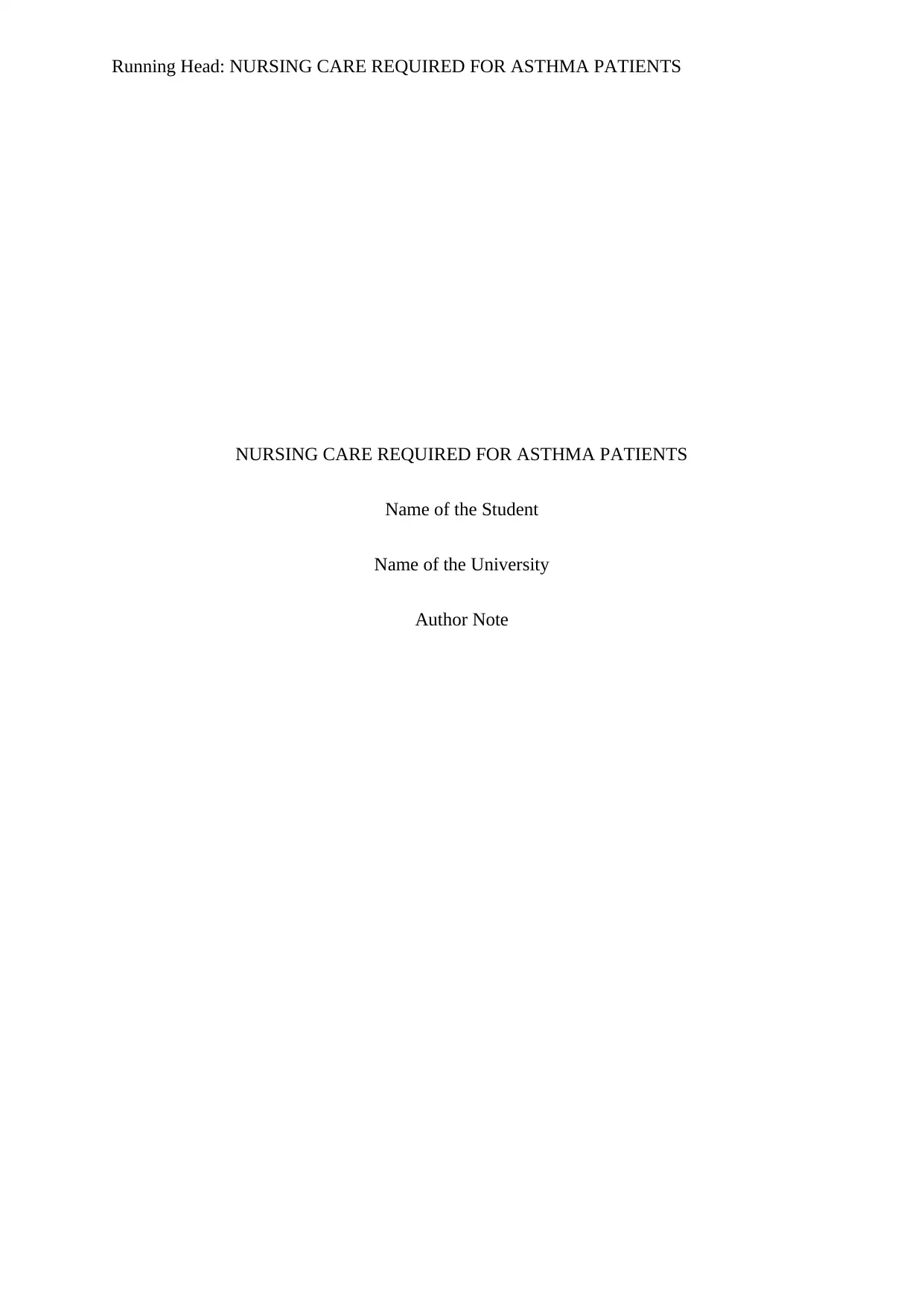
Running Head: NURSING CARE REQUIRED FOR ASTHMA PATIENTS
NURSING CARE REQUIRED FOR ASTHMA PATIENTS
Name of the Student
Name of the University
Author Note
NURSING CARE REQUIRED FOR ASTHMA PATIENTS
Name of the Student
Name of the University
Author Note
Paraphrase This Document
Need a fresh take? Get an instant paraphrase of this document with our AI Paraphraser
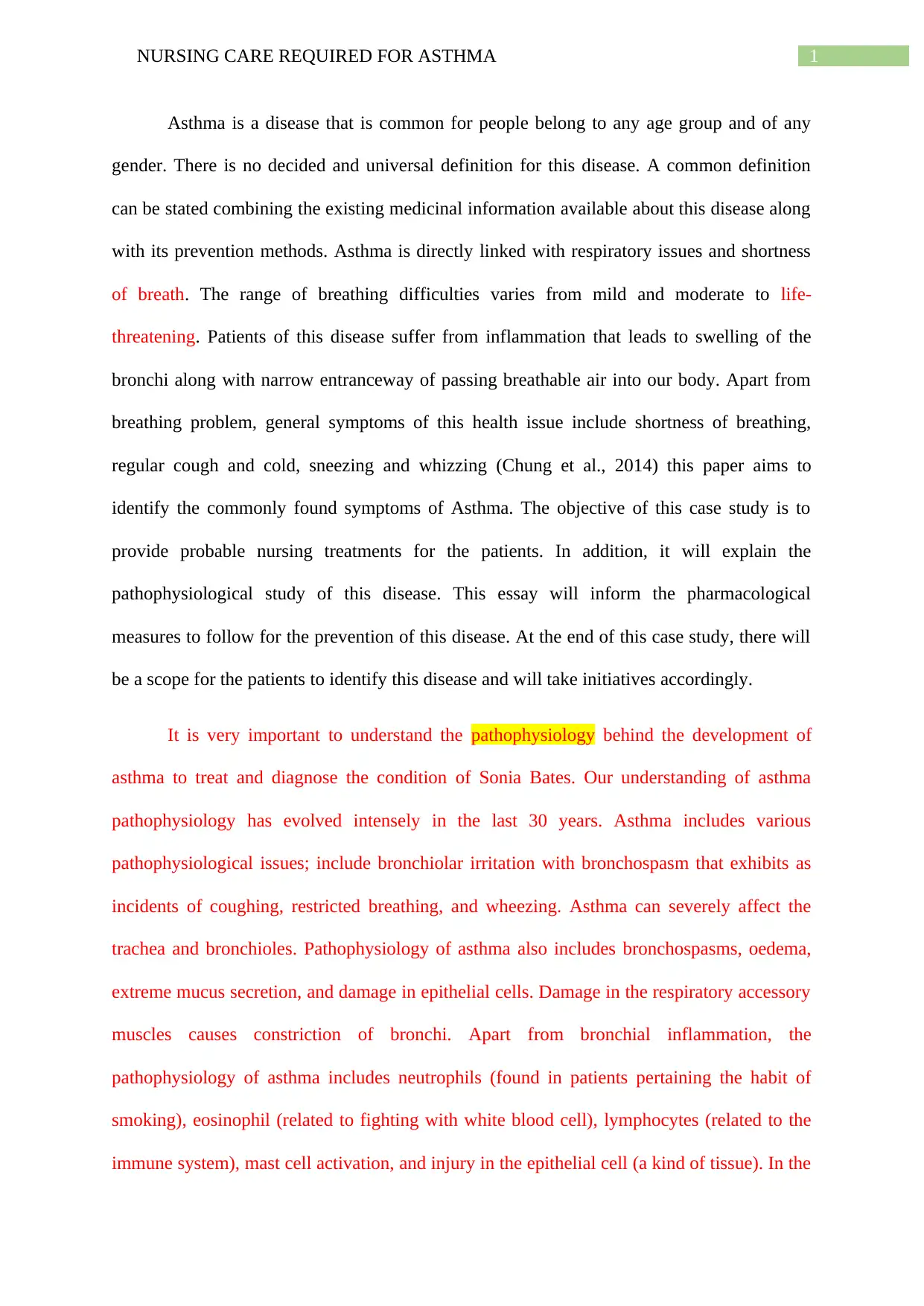
1NURSING CARE REQUIRED FOR ASTHMA
Asthma is a disease that is common for people belong to any age group and of any
gender. There is no decided and universal definition for this disease. A common definition
can be stated combining the existing medicinal information available about this disease along
with its prevention methods. Asthma is directly linked with respiratory issues and shortness
of breath. The range of breathing difficulties varies from mild and moderate to life-
threatening. Patients of this disease suffer from inflammation that leads to swelling of the
bronchi along with narrow entranceway of passing breathable air into our body. Apart from
breathing problem, general symptoms of this health issue include shortness of breathing,
regular cough and cold, sneezing and whizzing (Chung et al., 2014) this paper aims to
identify the commonly found symptoms of Asthma. The objective of this case study is to
provide probable nursing treatments for the patients. In addition, it will explain the
pathophysiological study of this disease. This essay will inform the pharmacological
measures to follow for the prevention of this disease. At the end of this case study, there will
be a scope for the patients to identify this disease and will take initiatives accordingly.
It is very important to understand the pathophysiology behind the development of
asthma to treat and diagnose the condition of Sonia Bates. Our understanding of asthma
pathophysiology has evolved intensely in the last 30 years. Asthma includes various
pathophysiological issues; include bronchiolar irritation with bronchospasm that exhibits as
incidents of coughing, restricted breathing, and wheezing. Asthma can severely affect the
trachea and bronchioles. Pathophysiology of asthma also includes bronchospasms, oedema,
extreme mucus secretion, and damage in epithelial cells. Damage in the respiratory accessory
muscles causes constriction of bronchi. Apart from bronchial inflammation, the
pathophysiology of asthma includes neutrophils (found in patients pertaining the habit of
smoking), eosinophil (related to fighting with white blood cell), lymphocytes (related to the
immune system), mast cell activation, and injury in the epithelial cell (a kind of tissue). In the
Asthma is a disease that is common for people belong to any age group and of any
gender. There is no decided and universal definition for this disease. A common definition
can be stated combining the existing medicinal information available about this disease along
with its prevention methods. Asthma is directly linked with respiratory issues and shortness
of breath. The range of breathing difficulties varies from mild and moderate to life-
threatening. Patients of this disease suffer from inflammation that leads to swelling of the
bronchi along with narrow entranceway of passing breathable air into our body. Apart from
breathing problem, general symptoms of this health issue include shortness of breathing,
regular cough and cold, sneezing and whizzing (Chung et al., 2014) this paper aims to
identify the commonly found symptoms of Asthma. The objective of this case study is to
provide probable nursing treatments for the patients. In addition, it will explain the
pathophysiological study of this disease. This essay will inform the pharmacological
measures to follow for the prevention of this disease. At the end of this case study, there will
be a scope for the patients to identify this disease and will take initiatives accordingly.
It is very important to understand the pathophysiology behind the development of
asthma to treat and diagnose the condition of Sonia Bates. Our understanding of asthma
pathophysiology has evolved intensely in the last 30 years. Asthma includes various
pathophysiological issues; include bronchiolar irritation with bronchospasm that exhibits as
incidents of coughing, restricted breathing, and wheezing. Asthma can severely affect the
trachea and bronchioles. Pathophysiology of asthma also includes bronchospasms, oedema,
extreme mucus secretion, and damage in epithelial cells. Damage in the respiratory accessory
muscles causes constriction of bronchi. Apart from bronchial inflammation, the
pathophysiology of asthma includes neutrophils (found in patients pertaining the habit of
smoking), eosinophil (related to fighting with white blood cell), lymphocytes (related to the
immune system), mast cell activation, and injury in the epithelial cell (a kind of tissue). In the
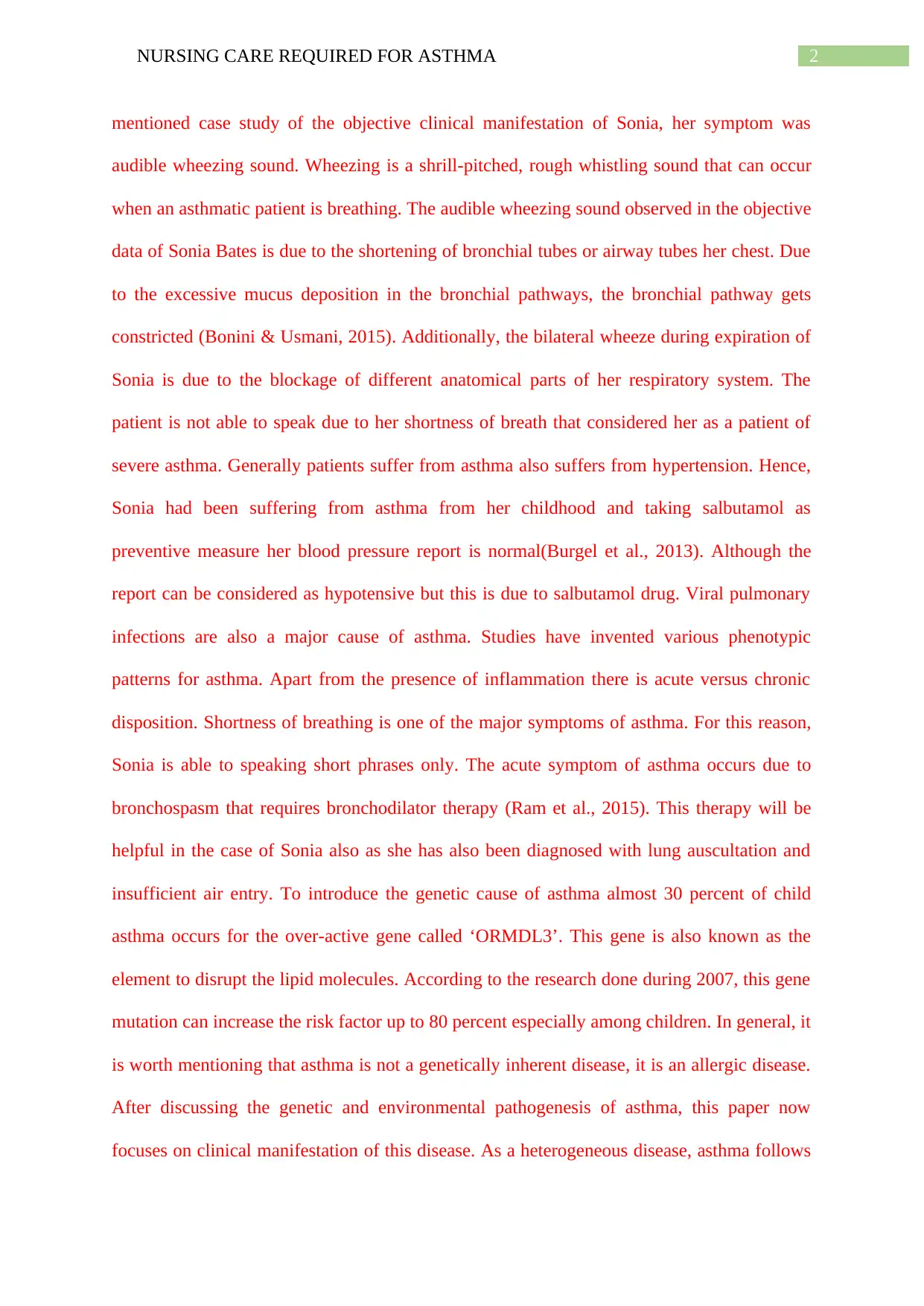
2NURSING CARE REQUIRED FOR ASTHMA
mentioned case study of the objective clinical manifestation of Sonia, her symptom was
audible wheezing sound. Wheezing is a shrill-pitched, rough whistling sound that can occur
when an asthmatic patient is breathing. The audible wheezing sound observed in the objective
data of Sonia Bates is due to the shortening of bronchial tubes or airway tubes her chest. Due
to the excessive mucus deposition in the bronchial pathways, the bronchial pathway gets
constricted (Bonini & Usmani, 2015). Additionally, the bilateral wheeze during expiration of
Sonia is due to the blockage of different anatomical parts of her respiratory system. The
patient is not able to speak due to her shortness of breath that considered her as a patient of
severe asthma. Generally patients suffer from asthma also suffers from hypertension. Hence,
Sonia had been suffering from asthma from her childhood and taking salbutamol as
preventive measure her blood pressure report is normal(Burgel et al., 2013). Although the
report can be considered as hypotensive but this is due to salbutamol drug. Viral pulmonary
infections are also a major cause of asthma. Studies have invented various phenotypic
patterns for asthma. Apart from the presence of inflammation there is acute versus chronic
disposition. Shortness of breathing is one of the major symptoms of asthma. For this reason,
Sonia is able to speaking short phrases only. The acute symptom of asthma occurs due to
bronchospasm that requires bronchodilator therapy (Ram et al., 2015). This therapy will be
helpful in the case of Sonia also as she has also been diagnosed with lung auscultation and
insufficient air entry. To introduce the genetic cause of asthma almost 30 percent of child
asthma occurs for the over-active gene called ‘ORMDL3’. This gene is also known as the
element to disrupt the lipid molecules. According to the research done during 2007, this gene
mutation can increase the risk factor up to 80 percent especially among children. In general, it
is worth mentioning that asthma is not a genetically inherent disease, it is an allergic disease.
After discussing the genetic and environmental pathogenesis of asthma, this paper now
focuses on clinical manifestation of this disease. As a heterogeneous disease, asthma follows
mentioned case study of the objective clinical manifestation of Sonia, her symptom was
audible wheezing sound. Wheezing is a shrill-pitched, rough whistling sound that can occur
when an asthmatic patient is breathing. The audible wheezing sound observed in the objective
data of Sonia Bates is due to the shortening of bronchial tubes or airway tubes her chest. Due
to the excessive mucus deposition in the bronchial pathways, the bronchial pathway gets
constricted (Bonini & Usmani, 2015). Additionally, the bilateral wheeze during expiration of
Sonia is due to the blockage of different anatomical parts of her respiratory system. The
patient is not able to speak due to her shortness of breath that considered her as a patient of
severe asthma. Generally patients suffer from asthma also suffers from hypertension. Hence,
Sonia had been suffering from asthma from her childhood and taking salbutamol as
preventive measure her blood pressure report is normal(Burgel et al., 2013). Although the
report can be considered as hypotensive but this is due to salbutamol drug. Viral pulmonary
infections are also a major cause of asthma. Studies have invented various phenotypic
patterns for asthma. Apart from the presence of inflammation there is acute versus chronic
disposition. Shortness of breathing is one of the major symptoms of asthma. For this reason,
Sonia is able to speaking short phrases only. The acute symptom of asthma occurs due to
bronchospasm that requires bronchodilator therapy (Ram et al., 2015). This therapy will be
helpful in the case of Sonia also as she has also been diagnosed with lung auscultation and
insufficient air entry. To introduce the genetic cause of asthma almost 30 percent of child
asthma occurs for the over-active gene called ‘ORMDL3’. This gene is also known as the
element to disrupt the lipid molecules. According to the research done during 2007, this gene
mutation can increase the risk factor up to 80 percent especially among children. In general, it
is worth mentioning that asthma is not a genetically inherent disease, it is an allergic disease.
After discussing the genetic and environmental pathogenesis of asthma, this paper now
focuses on clinical manifestation of this disease. As a heterogeneous disease, asthma follows
⊘ This is a preview!⊘
Do you want full access?
Subscribe today to unlock all pages.

Trusted by 1+ million students worldwide
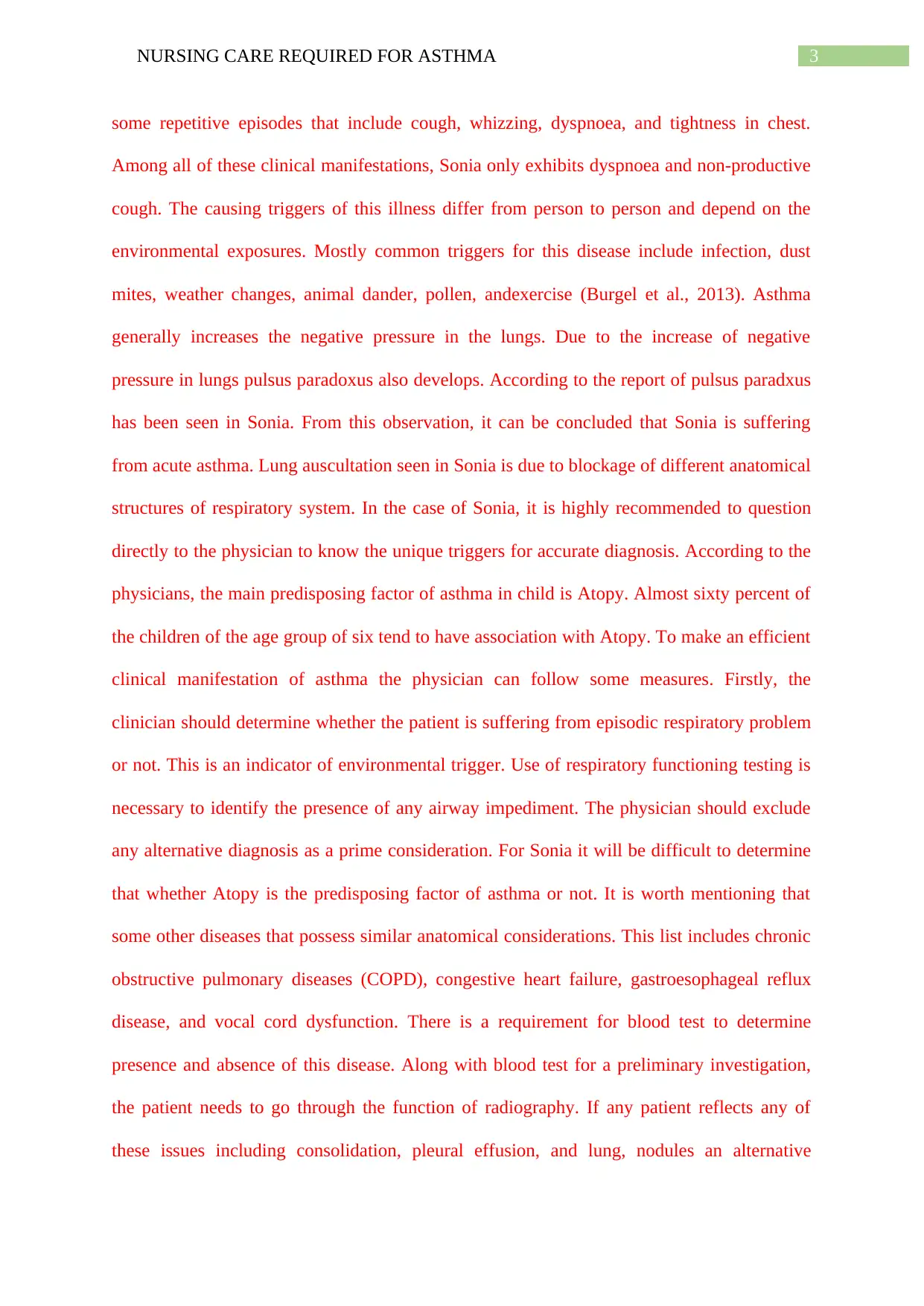
3NURSING CARE REQUIRED FOR ASTHMA
some repetitive episodes that include cough, whizzing, dyspnoea, and tightness in chest.
Among all of these clinical manifestations, Sonia only exhibits dyspnoea and non-productive
cough. The causing triggers of this illness differ from person to person and depend on the
environmental exposures. Mostly common triggers for this disease include infection, dust
mites, weather changes, animal dander, pollen, andexercise (Burgel et al., 2013). Asthma
generally increases the negative pressure in the lungs. Due to the increase of negative
pressure in lungs pulsus paradoxus also develops. According to the report of pulsus paradxus
has been seen in Sonia. From this observation, it can be concluded that Sonia is suffering
from acute asthma. Lung auscultation seen in Sonia is due to blockage of different anatomical
structures of respiratory system. In the case of Sonia, it is highly recommended to question
directly to the physician to know the unique triggers for accurate diagnosis. According to the
physicians, the main predisposing factor of asthma in child is Atopy. Almost sixty percent of
the children of the age group of six tend to have association with Atopy. To make an efficient
clinical manifestation of asthma the physician can follow some measures. Firstly, the
clinician should determine whether the patient is suffering from episodic respiratory problem
or not. This is an indicator of environmental trigger. Use of respiratory functioning testing is
necessary to identify the presence of any airway impediment. The physician should exclude
any alternative diagnosis as a prime consideration. For Sonia it will be difficult to determine
that whether Atopy is the predisposing factor of asthma or not. It is worth mentioning that
some other diseases that possess similar anatomical considerations. This list includes chronic
obstructive pulmonary diseases (COPD), congestive heart failure, gastroesophageal reflux
disease, and vocal cord dysfunction. There is a requirement for blood test to determine
presence and absence of this disease. Along with blood test for a preliminary investigation,
the patient needs to go through the function of radiography. If any patient reflects any of
these issues including consolidation, pleural effusion, and lung, nodules an alternative
some repetitive episodes that include cough, whizzing, dyspnoea, and tightness in chest.
Among all of these clinical manifestations, Sonia only exhibits dyspnoea and non-productive
cough. The causing triggers of this illness differ from person to person and depend on the
environmental exposures. Mostly common triggers for this disease include infection, dust
mites, weather changes, animal dander, pollen, andexercise (Burgel et al., 2013). Asthma
generally increases the negative pressure in the lungs. Due to the increase of negative
pressure in lungs pulsus paradoxus also develops. According to the report of pulsus paradxus
has been seen in Sonia. From this observation, it can be concluded that Sonia is suffering
from acute asthma. Lung auscultation seen in Sonia is due to blockage of different anatomical
structures of respiratory system. In the case of Sonia, it is highly recommended to question
directly to the physician to know the unique triggers for accurate diagnosis. According to the
physicians, the main predisposing factor of asthma in child is Atopy. Almost sixty percent of
the children of the age group of six tend to have association with Atopy. To make an efficient
clinical manifestation of asthma the physician can follow some measures. Firstly, the
clinician should determine whether the patient is suffering from episodic respiratory problem
or not. This is an indicator of environmental trigger. Use of respiratory functioning testing is
necessary to identify the presence of any airway impediment. The physician should exclude
any alternative diagnosis as a prime consideration. For Sonia it will be difficult to determine
that whether Atopy is the predisposing factor of asthma or not. It is worth mentioning that
some other diseases that possess similar anatomical considerations. This list includes chronic
obstructive pulmonary diseases (COPD), congestive heart failure, gastroesophageal reflux
disease, and vocal cord dysfunction. There is a requirement for blood test to determine
presence and absence of this disease. Along with blood test for a preliminary investigation,
the patient needs to go through the function of radiography. If any patient reflects any of
these issues including consolidation, pleural effusion, and lung, nodules an alternative
Paraphrase This Document
Need a fresh take? Get an instant paraphrase of this document with our AI Paraphraser
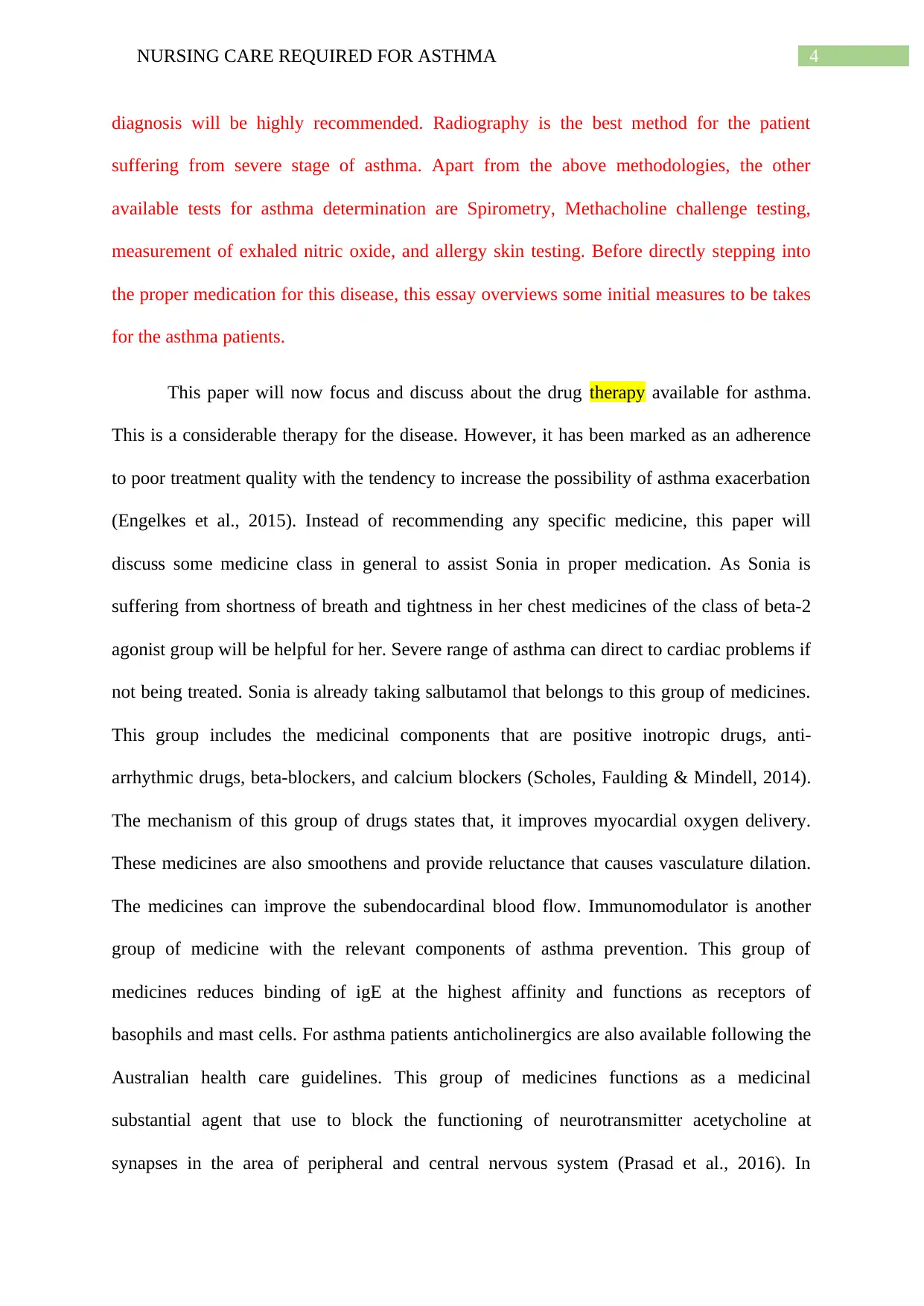
4NURSING CARE REQUIRED FOR ASTHMA
diagnosis will be highly recommended. Radiography is the best method for the patient
suffering from severe stage of asthma. Apart from the above methodologies, the other
available tests for asthma determination are Spirometry, Methacholine challenge testing,
measurement of exhaled nitric oxide, and allergy skin testing. Before directly stepping into
the proper medication for this disease, this essay overviews some initial measures to be takes
for the asthma patients.
This paper will now focus and discuss about the drug therapy available for asthma.
This is a considerable therapy for the disease. However, it has been marked as an adherence
to poor treatment quality with the tendency to increase the possibility of asthma exacerbation
(Engelkes et al., 2015). Instead of recommending any specific medicine, this paper will
discuss some medicine class in general to assist Sonia in proper medication. As Sonia is
suffering from shortness of breath and tightness in her chest medicines of the class of beta-2
agonist group will be helpful for her. Severe range of asthma can direct to cardiac problems if
not being treated. Sonia is already taking salbutamol that belongs to this group of medicines.
This group includes the medicinal components that are positive inotropic drugs, anti-
arrhythmic drugs, beta-blockers, and calcium blockers (Scholes, Faulding & Mindell, 2014).
The mechanism of this group of drugs states that, it improves myocardial oxygen delivery.
These medicines are also smoothens and provide reluctance that causes vasculature dilation.
The medicines can improve the subendocardinal blood flow. Immunomodulator is another
group of medicine with the relevant components of asthma prevention. This group of
medicines reduces binding of igE at the highest affinity and functions as receptors of
basophils and mast cells. For asthma patients anticholinergics are also available following the
Australian health care guidelines. This group of medicines functions as a medicinal
substantial agent that use to block the functioning of neurotransmitter acetycholine at
synapses in the area of peripheral and central nervous system (Prasad et al., 2016). In
diagnosis will be highly recommended. Radiography is the best method for the patient
suffering from severe stage of asthma. Apart from the above methodologies, the other
available tests for asthma determination are Spirometry, Methacholine challenge testing,
measurement of exhaled nitric oxide, and allergy skin testing. Before directly stepping into
the proper medication for this disease, this essay overviews some initial measures to be takes
for the asthma patients.
This paper will now focus and discuss about the drug therapy available for asthma.
This is a considerable therapy for the disease. However, it has been marked as an adherence
to poor treatment quality with the tendency to increase the possibility of asthma exacerbation
(Engelkes et al., 2015). Instead of recommending any specific medicine, this paper will
discuss some medicine class in general to assist Sonia in proper medication. As Sonia is
suffering from shortness of breath and tightness in her chest medicines of the class of beta-2
agonist group will be helpful for her. Severe range of asthma can direct to cardiac problems if
not being treated. Sonia is already taking salbutamol that belongs to this group of medicines.
This group includes the medicinal components that are positive inotropic drugs, anti-
arrhythmic drugs, beta-blockers, and calcium blockers (Scholes, Faulding & Mindell, 2014).
The mechanism of this group of drugs states that, it improves myocardial oxygen delivery.
These medicines are also smoothens and provide reluctance that causes vasculature dilation.
The medicines can improve the subendocardinal blood flow. Immunomodulator is another
group of medicine with the relevant components of asthma prevention. This group of
medicines reduces binding of igE at the highest affinity and functions as receptors of
basophils and mast cells. For asthma patients anticholinergics are also available following the
Australian health care guidelines. This group of medicines functions as a medicinal
substantial agent that use to block the functioning of neurotransmitter acetycholine at
synapses in the area of peripheral and central nervous system (Prasad et al., 2016). In

5NURSING CARE REQUIRED FOR ASTHMA
consideration of Sonia’s case study this group of medicines can have no or rare side effects.
In general, the side effect of this group of medicine includes dryness in the mouth and
increased rate of whizzing.
Every medicine or group of medicines requires particular way of management or
nursing care procedure to allow Sonia a normal life leading. Nursing management of Sonia as
an asthma patient requires immediate actions. For Sonia, the nurse needs to identify some
identical symptoms. Primarily the nurse needs to assess the status of respiratory system with
monitoring the critical condition of the symptoms. Sonia has been monitored with an audible
whizzing sound. Then the nurse needs to monitor the peak flow with peak flow meters. It
identifies the amount of passing air during the period of force expiration. This is required
only for the patients suffering from severe asthma. Sonia, as a severe asthma patient has been
diagnosed with predicted value of 75% peak flow. Chest x-ray is required for further
monitoring. In the case of Sonia, the x-ray diagnosis not detected with any abnormalities.
According to the above diagnosis the nurse need to apply the following procedures.
Ineffective airway clearance method is required to clear the identified non-productive cough
in Sonia. This will help her to overcome the issues related to the shortness of breath (Xia et
al., 2015).In case of consistency with the similar problem, the nurse need to follow impaired
gas exchange method. It is an alternative way to deliver oxygen in the patient’s body.
Effective bronchodilators are recommended for Sonia to maintain the physical condition
afterwards. Sonia is already a user of salbutamol. In case of requirement of alternative
medicines, some suggestive names are salmeterol, formoterol, and vilanterol, which belong to
the group of beta-2 agonists. A home visit of the nurse to further assess the health progress of
the patient is recommended to provide environment and home allergens for Sonia with
periodic exacerbation.
consideration of Sonia’s case study this group of medicines can have no or rare side effects.
In general, the side effect of this group of medicine includes dryness in the mouth and
increased rate of whizzing.
Every medicine or group of medicines requires particular way of management or
nursing care procedure to allow Sonia a normal life leading. Nursing management of Sonia as
an asthma patient requires immediate actions. For Sonia, the nurse needs to identify some
identical symptoms. Primarily the nurse needs to assess the status of respiratory system with
monitoring the critical condition of the symptoms. Sonia has been monitored with an audible
whizzing sound. Then the nurse needs to monitor the peak flow with peak flow meters. It
identifies the amount of passing air during the period of force expiration. This is required
only for the patients suffering from severe asthma. Sonia, as a severe asthma patient has been
diagnosed with predicted value of 75% peak flow. Chest x-ray is required for further
monitoring. In the case of Sonia, the x-ray diagnosis not detected with any abnormalities.
According to the above diagnosis the nurse need to apply the following procedures.
Ineffective airway clearance method is required to clear the identified non-productive cough
in Sonia. This will help her to overcome the issues related to the shortness of breath (Xia et
al., 2015).In case of consistency with the similar problem, the nurse need to follow impaired
gas exchange method. It is an alternative way to deliver oxygen in the patient’s body.
Effective bronchodilators are recommended for Sonia to maintain the physical condition
afterwards. Sonia is already a user of salbutamol. In case of requirement of alternative
medicines, some suggestive names are salmeterol, formoterol, and vilanterol, which belong to
the group of beta-2 agonists. A home visit of the nurse to further assess the health progress of
the patient is recommended to provide environment and home allergens for Sonia with
periodic exacerbation.
⊘ This is a preview!⊘
Do you want full access?
Subscribe today to unlock all pages.

Trusted by 1+ million students worldwide
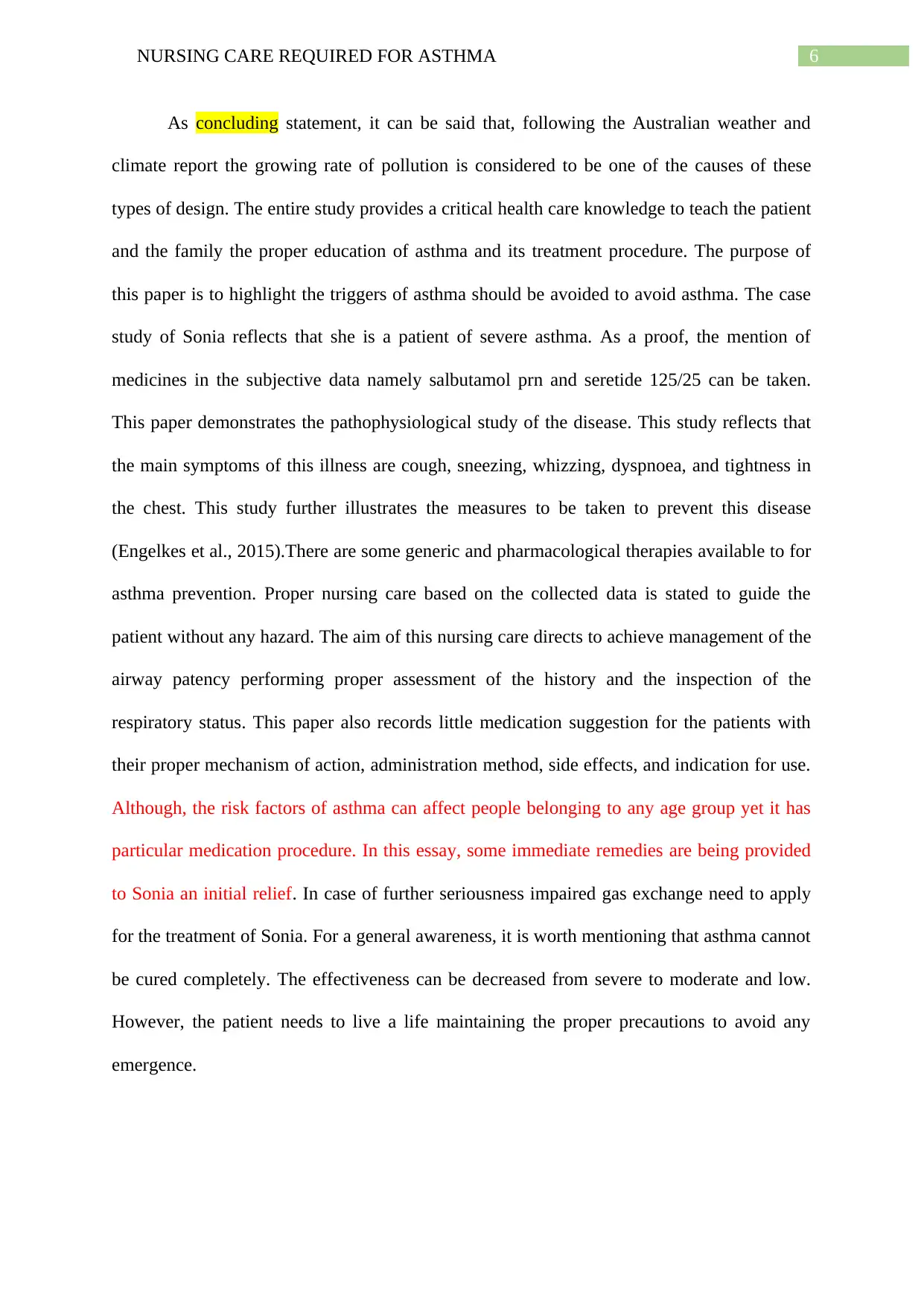
6NURSING CARE REQUIRED FOR ASTHMA
As concluding statement, it can be said that, following the Australian weather and
climate report the growing rate of pollution is considered to be one of the causes of these
types of design. The entire study provides a critical health care knowledge to teach the patient
and the family the proper education of asthma and its treatment procedure. The purpose of
this paper is to highlight the triggers of asthma should be avoided to avoid asthma. The case
study of Sonia reflects that she is a patient of severe asthma. As a proof, the mention of
medicines in the subjective data namely salbutamol prn and seretide 125/25 can be taken.
This paper demonstrates the pathophysiological study of the disease. This study reflects that
the main symptoms of this illness are cough, sneezing, whizzing, dyspnoea, and tightness in
the chest. This study further illustrates the measures to be taken to prevent this disease
(Engelkes et al., 2015).There are some generic and pharmacological therapies available to for
asthma prevention. Proper nursing care based on the collected data is stated to guide the
patient without any hazard. The aim of this nursing care directs to achieve management of the
airway patency performing proper assessment of the history and the inspection of the
respiratory status. This paper also records little medication suggestion for the patients with
their proper mechanism of action, administration method, side effects, and indication for use.
Although, the risk factors of asthma can affect people belonging to any age group yet it has
particular medication procedure. In this essay, some immediate remedies are being provided
to Sonia an initial relief. In case of further seriousness impaired gas exchange need to apply
for the treatment of Sonia. For a general awareness, it is worth mentioning that asthma cannot
be cured completely. The effectiveness can be decreased from severe to moderate and low.
However, the patient needs to live a life maintaining the proper precautions to avoid any
emergence.
As concluding statement, it can be said that, following the Australian weather and
climate report the growing rate of pollution is considered to be one of the causes of these
types of design. The entire study provides a critical health care knowledge to teach the patient
and the family the proper education of asthma and its treatment procedure. The purpose of
this paper is to highlight the triggers of asthma should be avoided to avoid asthma. The case
study of Sonia reflects that she is a patient of severe asthma. As a proof, the mention of
medicines in the subjective data namely salbutamol prn and seretide 125/25 can be taken.
This paper demonstrates the pathophysiological study of the disease. This study reflects that
the main symptoms of this illness are cough, sneezing, whizzing, dyspnoea, and tightness in
the chest. This study further illustrates the measures to be taken to prevent this disease
(Engelkes et al., 2015).There are some generic and pharmacological therapies available to for
asthma prevention. Proper nursing care based on the collected data is stated to guide the
patient without any hazard. The aim of this nursing care directs to achieve management of the
airway patency performing proper assessment of the history and the inspection of the
respiratory status. This paper also records little medication suggestion for the patients with
their proper mechanism of action, administration method, side effects, and indication for use.
Although, the risk factors of asthma can affect people belonging to any age group yet it has
particular medication procedure. In this essay, some immediate remedies are being provided
to Sonia an initial relief. In case of further seriousness impaired gas exchange need to apply
for the treatment of Sonia. For a general awareness, it is worth mentioning that asthma cannot
be cured completely. The effectiveness can be decreased from severe to moderate and low.
However, the patient needs to live a life maintaining the proper precautions to avoid any
emergence.
Paraphrase This Document
Need a fresh take? Get an instant paraphrase of this document with our AI Paraphraser

7NURSING CARE REQUIRED FOR ASTHMA
References
Anderson, K., & Emmerton, L. M. (2016). Contribution of mobile health applications
to self-management by consumers: review of published evidence. Australian
Health Review, 40(5), 591-597. doi.org/10.1071/AH15162
Bonini, M., & Usmani, O. S. (2015). The role of the small airways in the
pathophysiology of asthma and chronic obstructive pulmonary
disease. Therapeutic advances in respiratory disease, 9(6), 281-293. DOI:
10.1177/ 1753465815588064
Burgel, P. R., Bergeron, A., De Blic, J., Bonniaud, P., Bourdin, A., Chanez, P., ... &
Didier, A. (2013). Small airways diseases, excluding asthma and COPD: an
overview. European respiratory review, 22(128), 131-147. DOI:
10.1183/09059180.00001313
Chung, K. F., Wenzel, S. E., Brozek, J. L., Bush, A., Castro, M., Sterk, P. J., ... &
Boulet, L. P. (2014). International ERS/ATS guidelines on definition,
evaluation and treatment of severe asthma. European respiratory
journal, 43(2), 343-373.DOI: 10.1183/09031936.00034913
Engelkes, M., Janssens, H. M., de Jongste, J. C., Sturkenboom, M. C., & Verhamme,
K. M. (2015). Medication adherence and the risk of severe asthma
exacerbations: a systematic review. European Respiratory Journal, 45(2),
396-407. DOI: 10.1183/09031936.00075614
Prasad, K., Singh, M. B., & Ryan, H. (2016). Corticosteroids for managing
tuberculous meningitis. Cochrane Database of Systematic Reviews, (4).
retrieved from: https://doi.org/10.1002/14651858.CD002244.pub4
References
Anderson, K., & Emmerton, L. M. (2016). Contribution of mobile health applications
to self-management by consumers: review of published evidence. Australian
Health Review, 40(5), 591-597. doi.org/10.1071/AH15162
Bonini, M., & Usmani, O. S. (2015). The role of the small airways in the
pathophysiology of asthma and chronic obstructive pulmonary
disease. Therapeutic advances in respiratory disease, 9(6), 281-293. DOI:
10.1177/ 1753465815588064
Burgel, P. R., Bergeron, A., De Blic, J., Bonniaud, P., Bourdin, A., Chanez, P., ... &
Didier, A. (2013). Small airways diseases, excluding asthma and COPD: an
overview. European respiratory review, 22(128), 131-147. DOI:
10.1183/09059180.00001313
Chung, K. F., Wenzel, S. E., Brozek, J. L., Bush, A., Castro, M., Sterk, P. J., ... &
Boulet, L. P. (2014). International ERS/ATS guidelines on definition,
evaluation and treatment of severe asthma. European respiratory
journal, 43(2), 343-373.DOI: 10.1183/09031936.00034913
Engelkes, M., Janssens, H. M., de Jongste, J. C., Sturkenboom, M. C., & Verhamme,
K. M. (2015). Medication adherence and the risk of severe asthma
exacerbations: a systematic review. European Respiratory Journal, 45(2),
396-407. DOI: 10.1183/09031936.00075614
Prasad, K., Singh, M. B., & Ryan, H. (2016). Corticosteroids for managing
tuberculous meningitis. Cochrane Database of Systematic Reviews, (4).
retrieved from: https://doi.org/10.1002/14651858.CD002244.pub4

8NURSING CARE REQUIRED FOR ASTHMA
Ram, S., Zhang, W., Williams, M., & Pengetnze, Y. (2015). Predicting asthma-related
emergency department visits using big data. IEEE journal of biomedical and
health informatics, 19(4), 1216-1223. DOI: 10.1109/JBHI.2015.2404829
Scholes, S., Faulding, S., & Mindell, J. (2014). Use of prescribed medicines. NHS
Health Survey for England–2013. London: Health & Social Care Information
Centre, 2. retrieved from: http://healthsurvey.hscic.gov.uk/media/1052/_5-use-of-
prescribed-medicines_5th-proof.pdf
Xia, T., Nitschke, M., Zhang, Y., Shah, P., Crabb, S., & Hansen, A. (2015). Traffic-
related air pollution and health co-benefits of alternative transport in Adelaide,
South Australia. Environment international, 74, 281-290. retrieved from:
https://doi.org/10.1016/j.envint.2014.10.004
Xu, Z., Huang, C., Hu, W., Turner, L. R., Su, H., & Tong, S. (2013). Extreme
temperatures and emergency department admissions for childhood asthma in
Brisbane, Australia. Occup Environ Med, 70(10), 730-735.
http://dx.doi.org/10.1136/oemed-2013-101538
Ram, S., Zhang, W., Williams, M., & Pengetnze, Y. (2015). Predicting asthma-related
emergency department visits using big data. IEEE journal of biomedical and
health informatics, 19(4), 1216-1223. DOI: 10.1109/JBHI.2015.2404829
Scholes, S., Faulding, S., & Mindell, J. (2014). Use of prescribed medicines. NHS
Health Survey for England–2013. London: Health & Social Care Information
Centre, 2. retrieved from: http://healthsurvey.hscic.gov.uk/media/1052/_5-use-of-
prescribed-medicines_5th-proof.pdf
Xia, T., Nitschke, M., Zhang, Y., Shah, P., Crabb, S., & Hansen, A. (2015). Traffic-
related air pollution and health co-benefits of alternative transport in Adelaide,
South Australia. Environment international, 74, 281-290. retrieved from:
https://doi.org/10.1016/j.envint.2014.10.004
Xu, Z., Huang, C., Hu, W., Turner, L. R., Su, H., & Tong, S. (2013). Extreme
temperatures and emergency department admissions for childhood asthma in
Brisbane, Australia. Occup Environ Med, 70(10), 730-735.
http://dx.doi.org/10.1136/oemed-2013-101538
⊘ This is a preview!⊘
Do you want full access?
Subscribe today to unlock all pages.

Trusted by 1+ million students worldwide
1 out of 9
Related Documents
Your All-in-One AI-Powered Toolkit for Academic Success.
+13062052269
info@desklib.com
Available 24*7 on WhatsApp / Email
![[object Object]](/_next/static/media/star-bottom.7253800d.svg)
Unlock your academic potential
Copyright © 2020–2025 A2Z Services. All Rights Reserved. Developed and managed by ZUCOL.





